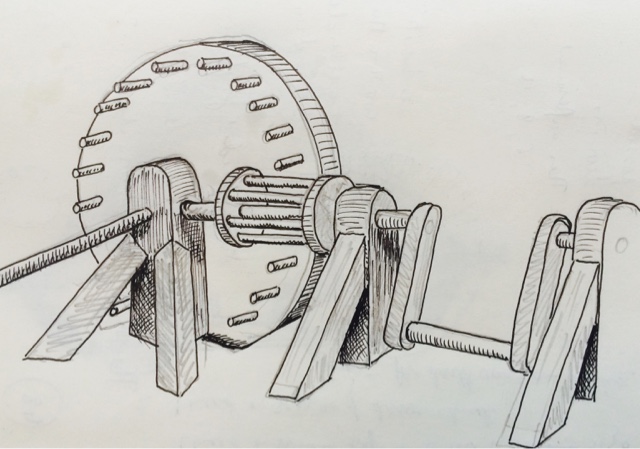I was commissioned to make a large scale model of one of the Florentine's war machines. I knew him to be a man of peace, and that he would not eat flesh, but he knew what side his bread was buttered on and kept in good favour by designing weaponry when it was asked for.
The loathsome Salai brought the drawings but I would not pay him the smallest penny to read the jotted notes. This one was easier to comprehend, for Leonardo made use of simple gears that one sees on any building site. I am a cabinet-maker, not a wagon-maker, but I can apply myself to any idea and make good of it. This one seemed simple. It was a little more than a large wooden basin, a kind of low slung barrel, or tank, pierced by four wheels which could be turned by handcrank driving a spoked drum which linked between projecting points from each wheel. As always I made my own drawing to help with my understanding of the parts in the procedures.
At first I was perplexed because the driving force of the gears was such that the two wheels on each side would turn in opposition to each other.
This detail seems like an error at first and I sketched two other possibilities so the drive of the drums would impel the wheels in the same direction.
But then I considered that the Florentine master, a man who does not draw details so much is suggest the action of his ideas, is not a man whose perceptions skip a beat. If he drew his gears in such a way then in such a way they were to be. And so I reflected on the requirements of this bizarre vehicle, and thought of the intriguing gears used by Brunelleschi in the building of the Florentine Duomo, and realized that each drum needed to be engaged at different times to achieve its specific purpose.
So it seemed to me that a man turning the crank, pushing outwards with his weight and pulling upwards and inwards with the force of his legs, would not want to reverse direction to reverse the motion of the vehicle. But by disengaging one wheel and re-engaging its mate then the same circular motion would move the wagon in the opposite direction. Similarly, two drivers could engage the wheels diagonally opposite in such a way that by turning together the whole contraption would rotate on the spot. It was to achieve this that I came up with the idea of a system of removable rods which would pass through a small fixed disk on the driveshaft into the free wheeling driving drum, thus locking the two parts together and extending the force to drive the wheels. Any two wheels appropriately joined by these removable pins would allow the vehicle to go forward, or backwards, or turn.
Given that this machine of war was a kind of gunship, the intent being to fire cannons in any direction necessary, such manoeuvrability seems paramount, and the engagement of any wheel in order to achieve limitless turning would be the wish of any commander.
My model was not big enough to be anywhere near the size of a real war machine, but it was certainly big enough that I could kneel in it and propel myself across a flat floor.
Once the base was made, and I felt confident in my driving system, the rest was easy enough to fill-in. I had to make the flared skirt around the perimeter, fashion small portals for the cannons, and then provide a kind of roof to offer protection for those inside from any kind of objects hurled or fired by an enemy.
One can't help but reflect that such a machine as this would instill great fear when first used upon the battlefield. One can imagine a war in which two sides are locked in a sort of stalemate and the one side, in an attempt to break through, comes forth with this amazing contraption firing guns and sowing fear. But yes, it is the way of warfare that after the innovation of one side the other soon follows. And in a short time both sides would be firing at each other from these armoured platforms. Where does the effort end? From each advance comes the new balance of power so neither side can win. Will it always be so with armies? It is an irony that Leonardo da Vinci, a man of peace, may be a visionary who sees a future where one weapon gives way to another until we have weapons greater than ourselves, perhaps a force of fire so vast it will destroy us all.







No comments:
Post a Comment